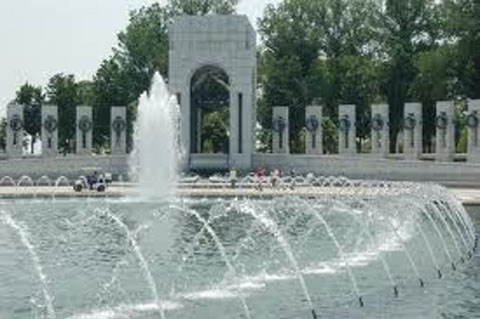
The World War II Memorial in Washington DC is a beautiful and solemn tribute to all who served their country during World War II. Veterans, have you been to the World War II Memorial in Washington DC?
If not click here

The World War II Memorial in Washington DC is a beautiful and solemn tribute to all who served their country during World War II. Veterans, have you been to the World War II Memorial in Washington DC?
If not click here
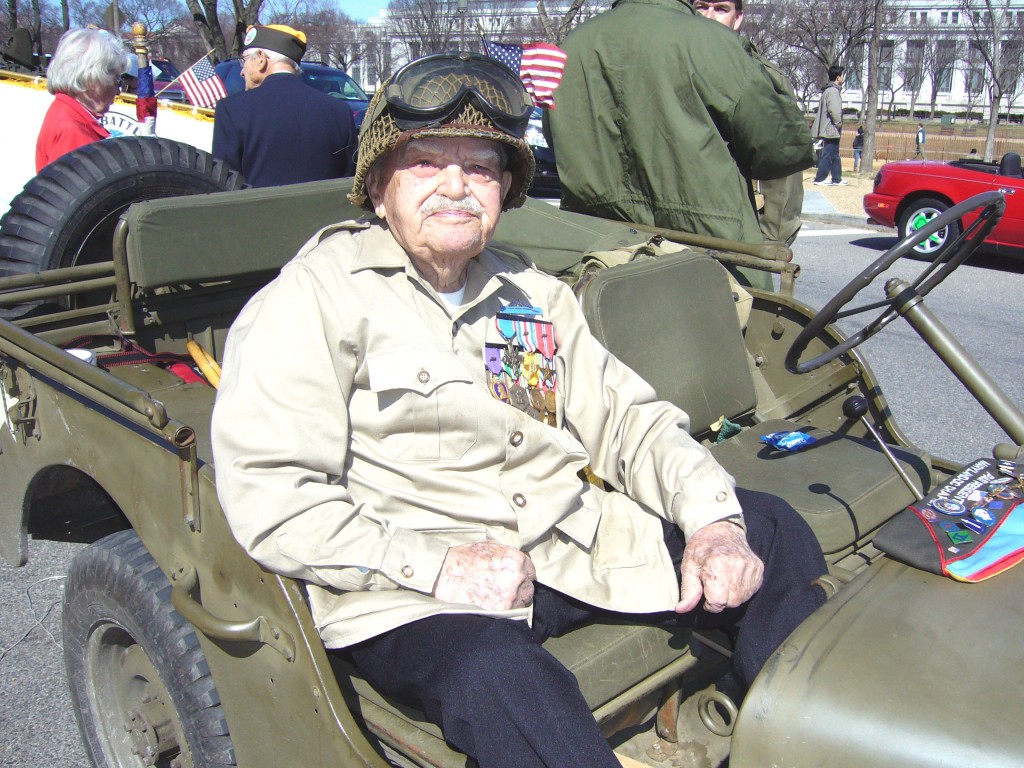
Edward Richard Radzwich, the designer of our Veterans of the Battle of the Bulge Certificate, died unexpectantly, under his magnolia tree on 9 July 2011. Ed conceived the design of the beautiful VBOB certificate on the back of a long Japanese calendar. Ed, faced with the dilemma of over 2,000 units that received the Ardennes Campaign credit and how to represent them, decided that each soldier in his unit would have had to have been attached to one of the major units (12th Army Group, or First, Third or First Allied Airborne Armies, or six Corps, or 33 Divisions or the units of the Eighth or Ninth Air Forces that supported the Bulge).
Thus, Ed took to cutting and pasting small copies of these major unit patches that fought in the Bulge and the flags of the United States, Belgium and Luxembourg. Photos from the National Archives Signal Corps Photo Collection to illustrate the harshness of the weather and the trudging through the forests satisfied with the concept and the wording it was turned over to a graphics artist and design company to finalize the design and prepare the artwork for printing. To date 8,000 of these Certificates have purchased by Bulge Veterans or their families in the Bulge Veterans name. The Veterans of the Battle of the Bulge are indeed indebted to Ed Radzwich for this Certificate of recognition for those who served in the Battle of the Bulge.
Ed Radzwich was born into a coal miner’s family in West Hazleton PA. He was an active Boy Scout, attaining the rank of Eagle Scout. A gifted high school graduate in the depression era and unable to afford further education, he saw the United States Army as his opportunity. He enlisted as a Private in May 1934 in the Chemical Corps. He completed service but was recalled from the Reserves in Feb 1941. Ed was selected to be one of the first groups of enlisted men to attend the new Officer Candidate School under BG Omar Bradley, at Fort Benning GA. Ed was being fitted at the tailors in Columbus GA, for his “Pinks & Greens,” Officer’s Dress uniform, when the news came over the radio that Pearl Harbor had been attacked, He graduated Infantry Officer Candidate School (OCS) class 41-3, one week after Pearl Harbor, Class 41-3 with a 2nd Lieutenant’s Commission.
He was assigned to the 26th Infantry (Yankee) Division, at Camp Edwards, Massachusetts, that December 1941, at the time when most of the unit was given leave for the Holiday’s. As a newly minted 2nd Lt, Ed was assigned as officer-in-charge of most everything on the post since virtually all of the National Guard officers had taken leave. Ed, undaunted, using his intellect and initiative, rose to the occasion, and performed in a superior way with little of no guidance. This was to become a hallmark of his service. He was to be as one of the first Ranger trainees to attend the First Ranger School, Camp Forrest, Tullahoma, Tennessee, in early 1943, where he graduated as a Ranger in the First Ranger Class. Ed was to remain with the “Yankee” Division throughout WWII advancing to Captain and Company Commander, I Company, 101st Infantry Regiment, prior to the unit leaving the states for combat.
Ed was one of the few company commanders to go into combat as a Company Commander and to come out of the war with the same company, which he led through the Campaigns of Northern France, Rhineland, the Battle of the Bulge (Ardennes) and central Europe. He was given R&R leave from Fulda Germany just before May 1945 and celebrated VE Day in New York City with his wife, Mary.
Ed was an outstanding Company Commander as attested to by his men, always leading from the front. For his heroic actions in combat he received the Distinguished Service Cross, Silver Star with two Oak Leaf Clusters, Bronze Star with two Oak Leaf Clusters, and Purple Heart with two Oak Leaf Clusters. He also received two awards of the Army Commendation Medal. He was most proud of his Combat Infantryman Badge. Ed was a true hero.
After the war he was offered a Regular Army commission on 5 Jul 1946. He was assigned to US Military Government in Korea Jul 1946 – June 1949 and because of his six month’s experience, as a youth, working in a coal mine in Pennsylvania, he was put in charge of all the coal mines in Korea. He also served as Army Instructor, NJ National Guard Sept 1949-May 1951; Battalion Commander 33 RCT, Panama Canal Zone, Jul 52 – Jan 1955; Chief of Civil Affairs, Assistant Chief of Staff G-5, Eighth Army, Korea, Feb 1957 – Jun 1958; and G-3, Second US Army, Reserve Components, Fort George G. Meade, Jul 58 – Feb 1961. He retired as a Lieutenant- Colonel in Mar 1961 with 25 years of service.
On August 8, 2003 Edward Radzwich lost his beloved wife, Mary. They had been married 64 years. He is survived by three children, Gloria, Virginia and Edward Jr., two grandchildren and three great grandchildren.
Honors & Citations:
Distinguished Service Cross, Silver Star w/2 Oak Leaf Clusters, Bronze Star w/2 Oak Leaf Clusters, Purple Heart w/2 Oak Leaf Clusters, Army Commendation Medal w/ Oak Leaf Cluster, Combat Infantryman Badge, Presidential Unit Citation. Installed in Infantry OCS Hall of Fame, Ft Benning, GA, March 1959. For his outstanding contributions and decorations as a soldier, LTC Edward R. Radzwich was elected to membership in the prestigious Legion of Valor. He served our country with great distinction. He was an outstanding patriot.
Sources: Michael Samberg, who served as an enlisted man under Captain Radzwich during WWII and John D. Bowen, VBOB Recording Secretary.
Monument Dedicated May 31, 2011
Military park unveils new memorial for Battle of the Bulge
by Kevin Allen, South Bend Tribune Staff Writer
Photos by Robert Franklin South Bend Tribune
Former British Prime Minister Winston Churchill called it “undoubtedly the greatest American battle” of World War II and an event he believes would “be regarded as an ever famous American victory.” It was the Battle of the Bulge – 40 days of fighting in the bitter cold of December 1944 and January 1945 to force the German army out of Belgium and Luxembourg in what was Adolf Hitler’s last best chance to turn the tide against the allies.
The American triumph over the Nazi onslaught led the way to victory in Europe the following spring and now the Battle of the Bulge is memorialized at the Military Honor Park and Museum next to South Bend Regional Airport. Park and museum officials hosted a ceremony Monday afternoon to unveil a granite monument dedicated to the 600,000 US soldiers who fought in the bloodiest American battle of World War II.
One of those US soldiers, Geza Csapo, of Osceola donated money for the monument. Csapo, 85 served in the Army from 1943 to 1945 and fought in tanks during the Battle of the Bulge. “This is a much-needed addition to the park”, he said of the monument “I dread to think what the world would be like today if the Germans had won”. Csapo said he was caught by surprise when the German attack began December 16, 1944. There wasn’t much time to think about the significance of the battle. All I remember he said “it is early one morning night turned into day”.
Frank Firtl a Mishawaka resident who worked in intelligence and reconnaissance for the Army during the Battle of the Bulge said the sky that morning looked like Disneyland on the Fourth of July.
Csapo came close to dying during the battle as a German soldier aimed a bazooka at his tank. Fortunately for Csapo he fired a shot before us German soldier did. Firtl, 94 also had several close calls as he moved behind enemy lines as a scout. He suffered a fractured skull and a blown out eardrum later in the war when the jeep he was riding in hit a land mine in Germany.
Louis Kobold another Mishawaka resident who fought in the Battle of the Bulge wasn’t able to witness the monument’s dedication Monday, he died in December 2009. Kobold’s family however was on hand for the event. I am sure he’s looking down and smiling at what happened here today his son Mark said. Louis Kobold nearly lost his feet to frostbite at the Battle of the Bulge and as a result he had trouble with his feet for the rest of his life. He also suffered a shrapnel injury there and slivers of metal continued surfacing in his hip for years after. His widow Dorothy said he kissed the ground when he returned to Mishawaka. But he never talked about the war he just hoped his children would never have to experience anything like it. They just want to come home get married and have children Dorothy Kobold said of the World War II veterans. They wanted to have a normal life because war was never normal.
Csapo said he reacted similarly when he returned stateside. I never said a word he said my children didn’t even know I was in the war until they were grown. But after talking about his experiences on a canoe trip in Michigan he said the stories poured out as if a damn had broken. Csapo quickly found it was important and therapeutic to pass on the history. With the new monument his contribution to keep that history alive will be permanent.
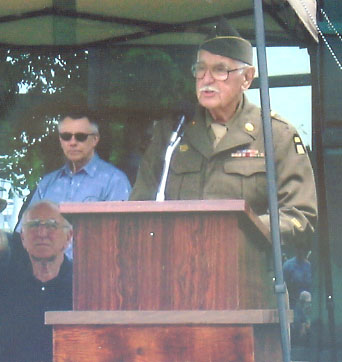
The Gateway Chapter was pleased to have a visit of a number of delegates from the Moscow School of Political Studies at the May meeting. The Russian visitors met with about 25 members to thank them for their service in World War II and hear their recollections of meeting Russian soldiers during the war. To honor V-E Day (May 8), the Russian delegates presented the Chapter with an evergreen tree, which was planted near the Battle of the Bulge Monument and WWII GI Statue in Jefferson Barracks Park a few days later.
The Russian delegates were llya V. Savchenko, Timur Botvin, Roman Ryabintsev, Georgy Kaytukov, Magomed Magomedomarov and Natalya Paleeva.The veterans, in return, gave the delegates a copy of our book, “Victory Through Valor: A Collection of World War II Memoirs,” and a photo of the Battle of the Bulge Monument and World War II GI Statue. The visit by the Russian group was through the auspices of the University of Missouri–St. Louis’ Center for International Studies and coordinated by Professor Jerol Enoch.
Photos by August Jennewein/UMSL
Veterans in above photo: Ray Saul (4th Infantry Division), Dick Cotter (26th Infantry Division)
Bernie Schwender (78th Infantry Division), Richard Coyle (28th Infantry Division)
Billy Stiegemeier (87th Infantry Division), Barny Baker (328th Fighter Control Squadron)
President Kent Stephens (26th Infantry Division), Don Green (106th Infantry Division)
Clyde Erb (26th Infantry Division), Eugene Ganz (1st Infantry Division)
Glen Jarvis (467th AAA AW), Marvin Korte (84th Infantry Division)
Ralph Forys (26th Infantry Division), Stanley Gibson (99th Infantry Division)
Harold Mueller (110th AAA 90MM MBL), Rusty Pendleton (11th Armored Division)
H.R.H. Prince Philippe and H.R.H. Princess Mathilde of Belgium, and Major General Michael S. Linnington, Commander of the Joint Force Headquarters National Capital Region participated in a wreath laying ceremony at the Battle of the Bulge Memorial in Arlington National Cemetery on Sunday, June 26, 2011. The event honored the fallen heroes in America’s largest land battle in history.
The Crown Prince and Princess spoke individually to all Bulge veterans present in recognition of their service to their country and Belgium during World War II. The Prince, the next heir to the throne, was very cordial and warmhearted in his remarks to the Veterans and responsive to their comments.
We at VBOB were indeed pleased at our large representation of Veterans and Associate Members of the Veterans of the Battle of the Bulge along with their friends and family who also attended this special event.
Also present for the ceremony were H.E. Steven Vanackere, Deputy Prime Minister of Belgium, Ambassador and Mrs. Jan Matthysen, Military Attaché Mike Delobel and other Belgium dignitaries.
The Prince and Princess participated in a public wreath ceremony at the Tomb of the Unknowns prior to the commemorative event at the Battle of the Bulge Monument in Section 21 of Arlington Cemetery.
The royal couple came to Washington with a delegation of 300 Belgian business men to help create investment and trade for Belgium. The princess married into the royal family in 1999 and now lives the life of a modern monarch, raising four children, embracing causes, and preparing to be queen one day.
We at VBOB are indeed proud to have this famous young couple as our friends.
J. David Bailey, National President, VBOB
The following photos were submitted by Robert Rhodes.
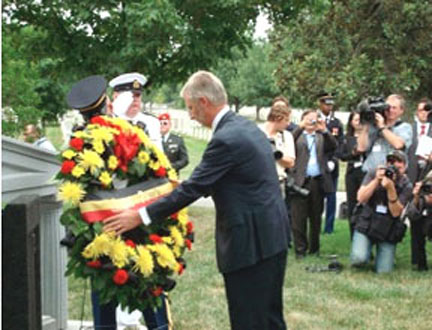
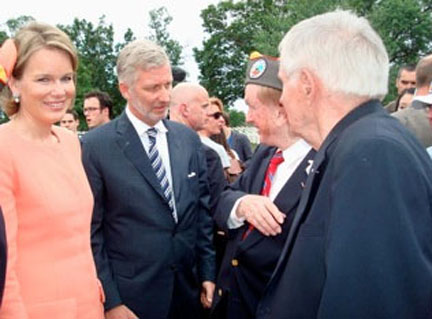
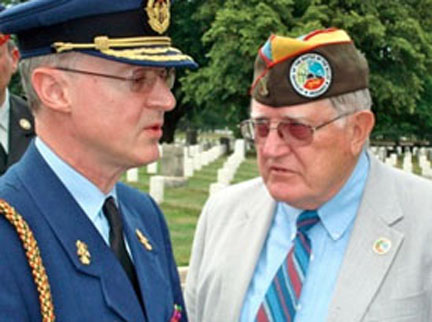
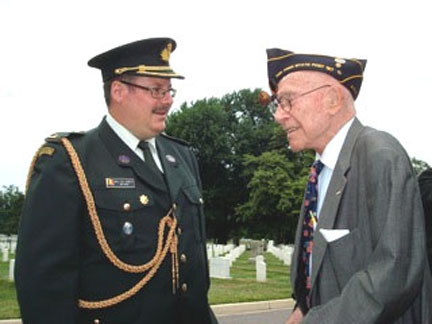
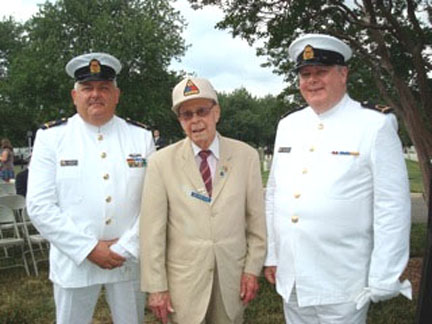
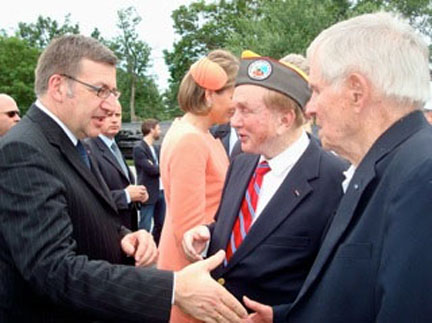
The Golden Gate Chapter held their Memorial Service on December 11, 2010 at the Fort Miley (SFVA Medical Center) in San Francisco, CA.
(Standing left to right) Martin Turkington, Honorable George Schmit (Luxembourg), Doris Davis, John P. Althuizen, Warren Jensen, Dean Woo, William Armstrong, John H. Rousch, Dame Rita Bral (Belgium), Tom Morgan, John Vassalo
(Seated left to right) Russell Hardeman, Mort Tallen, May Alm, Bob Bee, George Shilla
Interview: Survivor of the Battle of the Bulge
by Anna Davis
I have always been intrigued by the people who lived through and survived World War II. I enjoy watching the HBO series “The Band of Brothers” directed by Tom Hanks and Steven Spielberg. A particular battle that was life threatening for many American troops was the “Battle of the Bulge.” This particular battle took place in Belgium and included 52 days of combat. The troops who fought during this battle were not properly equipped for the weather and the temperatures were extremely cold. I wanted to know the details about the conditions of the “Battle of the Bulge.”
I casually know a man who attends my church named Richard Hugh Wheeler. Every Sunday, he is the gentleman who greets and opens the doors for everyone. By purely looking at his physical appearance, I would have never guessed he was 86 and a WWII veteran. When I learned he actually survived the “Battle of the Bulge,” I knew he was the perfect candidate for my interview. When I asked if he would oblige me, he was very enthusiastic. Mr. Wheeler was a credible source because he was a participant in this renowned event and lived through a very challenging time period. The interview took place in person on March 3, 2011 at the Wheeler residence.
The first couple of questions I asked Mr. Wheeler were background questions to lead up to the “Battle of the Bulge.” I wanted to know prior experience, skills, and the branch of the army he served. He told me he was 20 to 21 years old during the war. Mr. Wheeler was a trained paratrooper with a total of nine jumps, one into combat. He chose to be a paratrooper because it paid $60 more per month than other positions. Mr. Wheeler said his mother specifically told him not to be a paratrooper, but he became one In spite of her request. Mr. Wheeler was in seven battles including the “Battle of the Bulge.” He received a battle star for each of the seven.
Mr. Wheeler was in the Ardennes Forest during the “Battle of the Bulge,” and I wanted to know about the conditions of the Ardennes and what part of the battle he experienced. Specifics were important to me, so I could make a mental picture. He began by telling me that there were 52 total days in the battle, but his platoon was only there for thirty six. However, those 36 days were the most difficult days compared to any other combat Mr. Wheeler experienced. For the entire 36 days, the troops were outside. December of 1944 is still on record as one of the coldest winters in Europe’s recorded history.
The average temperature ranged from 10 to 20 degrees below zero. All the men were without winter clothing; Mr. Wheeler was only in his jump gear. It is beyond my imagination to think about how cold it was. Also, Mr. Wheeler did not have any gloves even when there was snow on the ground. Somehow during this time, Mr. Wheeler manage to save all his extremities. He still suffers from frostbite damage today, but it is his interior circulation that is the reminder. Everyone slept in “fox holes” which the troops dug with their personal shovels. These holes were not works of art; they were about 18″ by 20″ and just deep enough to crouch in. There was no wandering around and talking to friends. A person spoke when spoken to, advanced when commanded, and did not even sleep until told to do so. Mr. Wheeler was not even allowed to make a fire, or else the enemy would spot him. For all 36 days, Mr. Wheeler barely slept at all. Most of the time all he did was move forward and dig more fox holes, and fire at an often unseen enemy.
Next, I asked Mr. Wheeler about his hygiene. He only had one pair of clothes at the battle, and he slept in a dirt hole. I wondered if he ever bathed. Mr. Wheeler said only once did the group shower in 36 days, and that it was against his will. One of the men in Mr. Wheeler’s company had an Infection called scabies. Everyone was commanded to shower. There were showers set up outside and everyone had to strip down completely. The temperature was still ten below. Mr. Wheeler said “that was when I thought I was going to die.” Showering was not worth it in the intense cold. The men got their clothes washed, but not dried. I asked him how he managed to get his clothes dry in the extreme cold. He said you just had to lay on them over night.
I was curious to whether Mr. Wheeler was ever without food. Among all the discomforts of being cold and dirty, hunger was not an issue. He was always supplied with “K” or “C” rations. Both of these are bundles of food that provide three daily meals. The letters do not stand for anything, they are just the letters of the alphabet. Mr. Wheeler was not supplied with gourmet hot steaming food, but he was not hungry.
When I asked Mr. Wheeler how he had been able to survive the bitter cold and uncomfortable sleeping conditions, he said his basic training prepared him well. With a lot of discipline, and learning not to complain, he was suited for the roughest of situations.
After talking to Mr. Richard Wheeler, I have a much better understanding about what WWII veterans went through. I was mortified to think about the cold, and everyone’s personal hygiene. Mr. Wheeler also mentioned a story of a fellow soldier who urinated in his fox hole. The next morning, his legs were frozen to the ground. I respect Mr. Wheeler’s ability to live through the conditions he described. Overall, I felt my interview with Mr. Wheeler really helped my search and elevated my personal opinion about WWII veterans. I greatly appreciate the time Mr. Wheeler dedicated to me and all the information he was willing to supply.
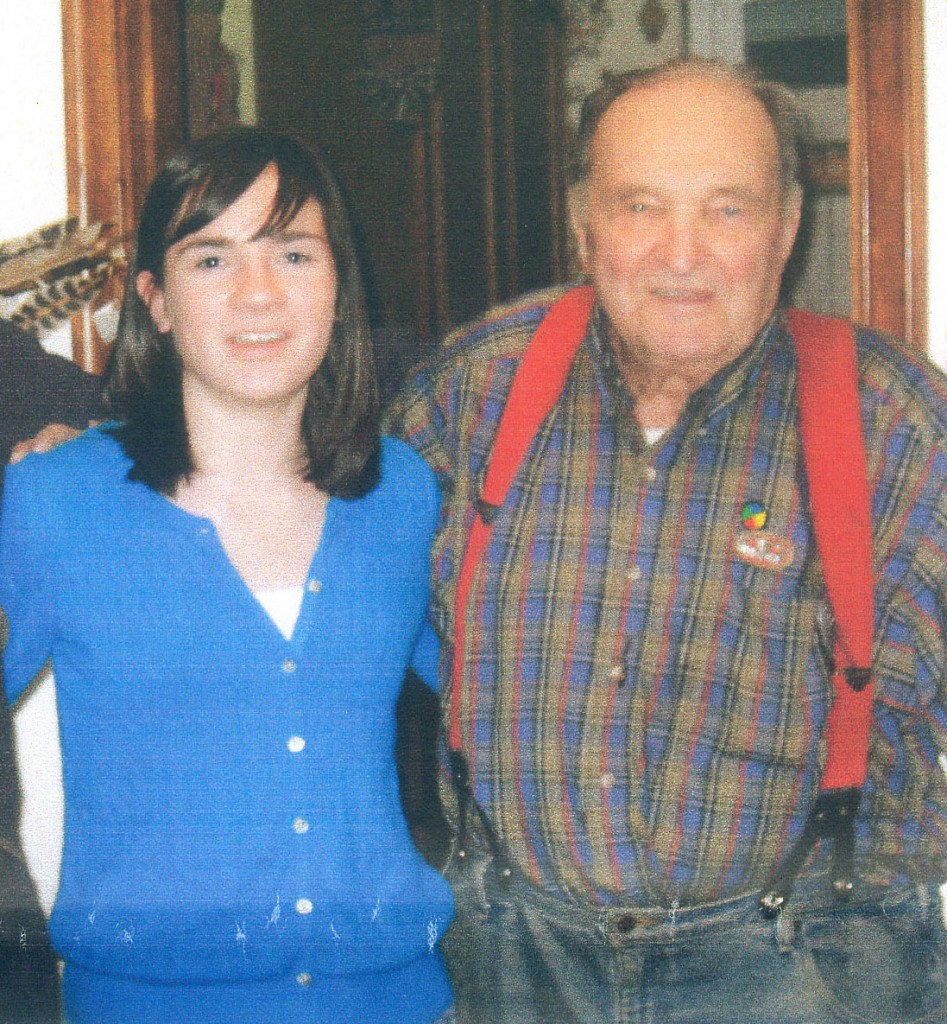
Linda Rea, daughter of William Rea, who fought in the Battle of the Bulge, flew home in April to surprise her Father. She enrolled him as a Member of the Veterans of the Battle of the Bulge, (VBOB), she herself joined as an Associate Member. She gave her father a Battle of the Bulge lanyard medallion along with eight other medals from WWII including the Soldiers Medal. In addition Linda made arrangements for Senator Mike Fasano of Florida to present her father with a Veterans of the Battle of the Bulge certificate.

Later on Linda and her father visited with Jack Ness, another veteran, of that horrific battle and William presented Jack with a Battle of the Bulge lanyard medallion.
Read story
Frederick Desmet, a Belgium citizen has adopted the grave of Wayne L. Shumate, a United State’s soldier who fought in the Battle of the Bulge. Frederick is one of many Belgium citizens who pay homage to their fallen heroes. Every year these goodwill ambassadors visit the site of their adopted grave to show appreciation for their liberation from tyranny.
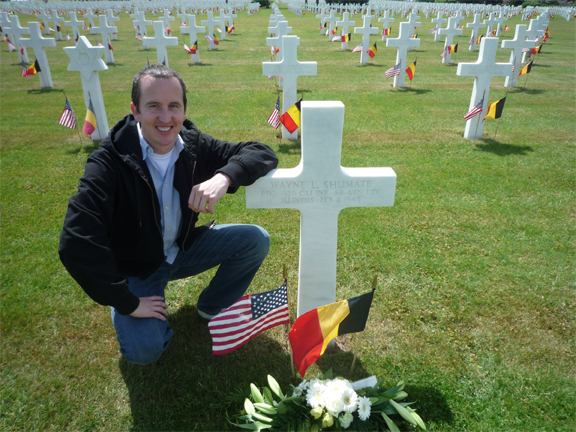
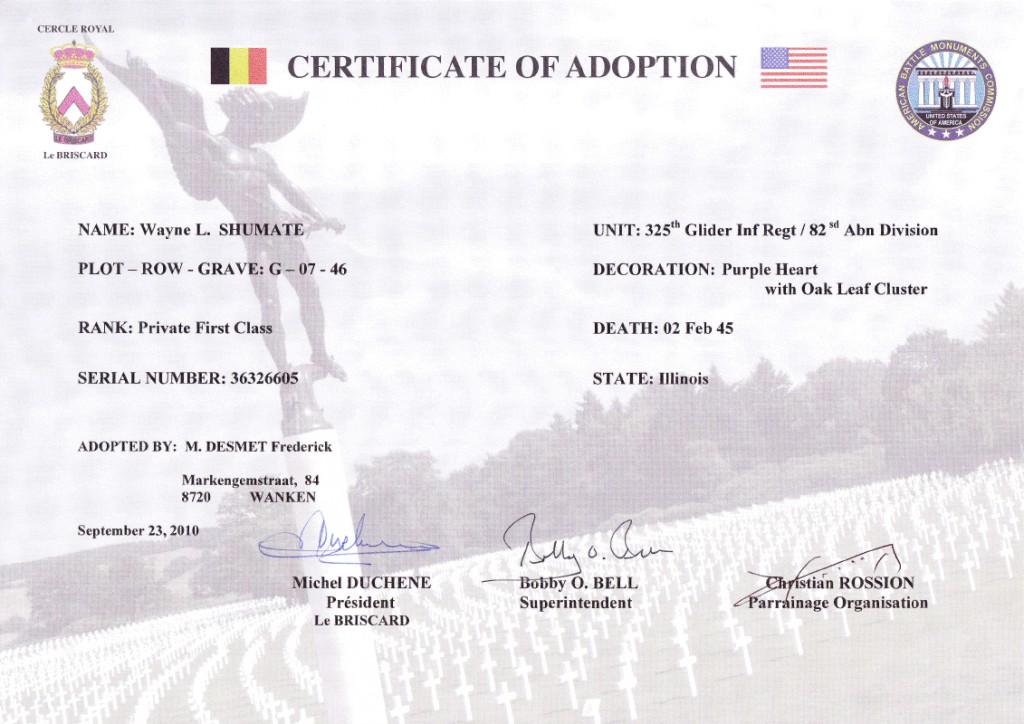
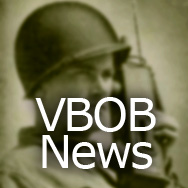

Wayne Field, President of the Rocky Mountain chapter, and a disabled Army veteran who served in the 6th Armored Division from Colorado Springs, CO won gold medals in three swimming events at the 30th National Veterans Wheelchair Games, from July 7-9, 2010 in Denver, Colorado. Attracting nearly 600 athletes each year, the National Veterans Wheelchair Games are the largest annual wheelchair sports event in the world.
Wayne was one of 12 gold medal winners of the 2007 Games to appear on special Cheerios boxes, which were sold at VA medical centers throughout America to promote the ’08 Games in Omaha, Neb. He has won more than 200 gold medals in 25 years of competing in national events like the Veterans Wheelchair Games.
Congratulations to a true champion!
Read about Wayne

Lara Center is writing an article about Jewish soldiers that fought in Luxembourg during the Battle of the Bulge. The article will be published in the “Jewish Veteran”, the official publication of the Jewish War Veterans of the USA.
Lara worked with Roland Gaul, curator of the Musée National d’Histoire Militaire in Diekirch, Luxembourg and was the recipient of the 2009 Secretary of State’s Award for Outstanding Volunteerism Abroad in Europe for outreach and education work.
Contact Lara Center at:
2717 Westford Ct
Falls Church, VA 22043
cell phone 571-319-7075

Chapter 30 President Barry J. Veden Speaks at AMVETS Convention
On Saturday, June 4, 2011, Chapter 30 President Barry J. Veden spoke to the Indiana State AMVETS Convention in Indianapolis, Indiana. His talk was on the Battle of the Bulge and the men who fought in it.
“I was humbled and felt honored to be speaking to the AMVETS attendees,” Veden said. “They are such an honorable organization and perform wonderful work for our veterans. I was proud to be able to represent, not only our northern Indiana chapter, but all of the men who fought so valiantly during the largest land battle ever fought by the United States Army.”
At the conclusion of his presentation, a booth was set up where Veden was able to sign copies of his book, My Heroes, a compilation of interviews with 30 members of Chapter 30. The book was published in 2004, and since its original publication, 19 of the men interviewed for the book, including his father Edward (28th Inf. Div.), have passed away. “I feel blessed that I was able to conduct the interviews when I did so that those men’s stories about World War II and the battle they fought in will not be forgotten,” the Chapter 30 president said.
AMVETS is an all-volunteer organization originally formed on December 10, 1944, in Kansas City, Missouri. On July 23, 1947, President Harry S. Truman signed Public Law 216, making AMVETS the first World War II organization chartered by Congress.
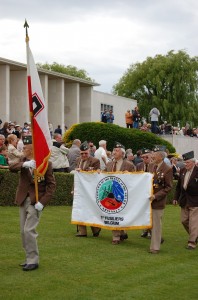
Members of the Belgian 5th Fusiliers and many other Belgium citizens pay their respects at the Henri Chapelle Cemetery, Belgium on Memorial Day. Carrying the Veterans of the Battle of the Bulge Flag are from left to right: Robert Lemaire, Marcel D’Haese & Jean Bartet. Christian Jacob is carrying the “A” flag.
Information submitted by Henri Rogister
Donald Schoo, a World War II veteran who served in the 80th Infantry Division, 633rd AAA AW Battalion and fought in the Battle of the Bulge received his honorary degree on May 14, 2011. Read the details.
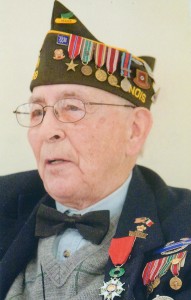
|